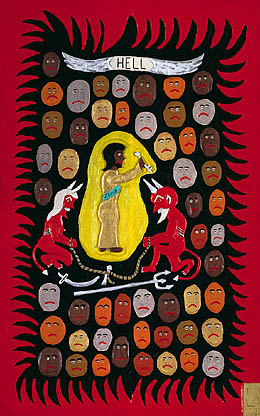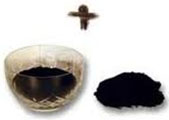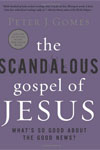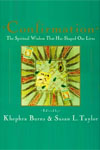|

Wilderness Hell by Leroy Almon, Sr.
ASH WEDNESDAY
(The Beginning of the Lenten Season)
Wednesday, February 22, 2012
Writer for This Unit: Elvin J. Parker III, member of the African American Lectionary Team
The unit you are viewing, Ash Wednesday, is a compact unit. This means that it is not a complete commentary of the Scripture(s) selected for this day on the calendar, nor does it have a full supporting cultural resource unit and worship unit. Instead, to enliven the imagination of preachers and teachers, we have provided a sermonic outline, songs, suggested books, and suggested articles, links, and videos. For additional information see Ash Wednesday in the archives of the Lectionary for 2008–2011. 2011 was the first year that the African American Lectionary posted Compact Units for moments on its Liturgical Calendar.
I. Description of the Liturgical Moment
“The Day of Ashes” or Ash Wednesday, as it is more commonly known, falls on the Wednesday of the seventh week before Easter and is the date that marks the start of the Holy Lenten Season for Christians around the World. Ash Wednesday follows Mardi Gras or Shrove Tuesday. It is a time for reflection, repentance, renewal, prayer, and personal sacrifice. The Lenten Season culminates on Easter Sunday Morning with the Easter Sonrise Service (the Service is called this because it is supposed to mark the Resurrection hour of the Savior, the Son of God).

The actual Season is inaugurated with the imposition of “Ashes” upon the foreheads of the participants in the Seasonal Discipline. The ashes themselves are penitential signs that represent mourning and grief expressed in response to the Passion of our Lord and Christ in his ultimate sacrifice of death on the cross for the redemption of the sins of everyone who would believe in this great Salvific Act. Ashes are used in this action as a reminder of our need to repent, confess our sins, and return to God.

The ashes are made from the palms and palm fronds that were blessed, reserved, and now burned from the previous year’s Passion/Palm Sunday Services to be used for Ash Wednesday observance the next year. Each participant in the Observance receives the imposition of the ashes upon the forehead in the form of the cross. The imposition of ashes is a startling reminder of the shortness of human life as it is reflected in the Interment ritual, “earth to earth, ashes to ashes, dust to dust.” Ashes also point toward cleansing and renewal, as in ancient times ashes were often used in lieu of soap and water for bathing.

Persons wishing to participate in the Lenten Season Discipline are invited to come to the altar or the front of the Sanctuary where a minister will dip his or her thumb in the vessel that contains the ashes and with his or her thumb mark a small cross upon the forehead of the participant/penitent. When the ashes are imposed the Verba that is generally used is, “From dust thou art, to dust thou shalt return. Repent and believe the Gospel,” or some such similar language.
When the size of the congregation warrants it is not unusual for the chief celebrant to have concelebrants to assist in the Imposition of Ashes. Forming several Imposing Stations for the convenience of the congregation will prove advantageous as well. When additional stations are used in those congregations that utilize the chancel rail as a kneeling place for the Imposition, several prie-dieus can be used at the various other stations. It is commonly expected that no ushering is necessary as people move voluntarily toward the place of Imposition. During the act of Imposition silence may be kept, instrumental music may be performed, or there may be soft singing by a choir and/or the congregation.
The Ash Wednesday Observance Service is traditionally held at noon, though many congregations also hold a second Service in the evening so that as many persons who desire to participate may have an opportunity to do so.
With this material as our backdrop, we provide a sermonic outline for Ash Wednesday Observance 2012.
II. Ash Wednesday: Sermonic Outline
A. Sermonic Focus Text(s): Matthew 6:1-6 (New Revised Standard Version)
(v. 1) “Beware of practicing your piety before others in order to be seen by them; for then you have no reward from your Father in heaven. (v. 2) So whenever you give alms, do not sound a trumpet before you, as the hypocrites do in the synagogues and in the streets, so that they may be praised by others. Truly I tell you, they have received their reward. (v. 3) But when you give alms, do not let your left hand know what your right hand is doing, (v. 4) so that your alms may be done in secret; and your Father who sees in secret will reward you. (v. 5) And whenever you pray, do not be like the hypocrites; for they love to stand and pray in the synagogues and at the street corners, so that they may be seen by others. Truly I tell you, they have received their reward. (v. 6) But whenever you pray, go into your room and shut the door and pray to your Father who is in secret; and your Father who sees in secret will reward you.”
B. Possible Titles
i. Rules, Reproofs, and Rewards
ii. The 3 R’s of Lenten Discipline
iii. The “Why” Behind the “What” of Lent
C. Point of Exegetical Inquiry
In any text there can be several words or phrases that require significant exegetical inquiry. One exegetical inquiry raised by this text is the refutation and dismissal of a sense of piety that is self-serving or that has negated its principle object as the worship or glorification of God in God’s own self-sacrifice through death on Calvary.
One may be easily tempted to ignore the more salient and deeper truths of the Holy Lenten Season and fixate their attention on their own momentary or seasonal sacrifice juxtaposed to God’s ultimate sacrifice in the work of redemption. We ought to continually be reminded and, indeed, remind ourselves that the purpose of the Holy Lenten Season is solely to cause us to reflect upon our failure to please God for which we should repent. It also gives us reason to celebrate our Redemption because of God’s greater sacrifice rendered on our behalf.
III. Introduction
Well, today is the day that in the words of the author of the Letter to the Hebrews, “We lay aside the weight and the sin that doth so easily beset us and run with patience the race that is set before us” (Hebrews 12:1).
The Lenten season is 40 days long. However, all mature Christians know that this is a life-long season.
In the passage appointed for our consideration today we find Jesus laying out some very serious and strict rules while offering advice on governing one’s piety so as to please God as we proceed to embark upon this season of self-sacrifice.
Move/Point One – How to Give to God
a. Rule: Do not give just to be acknowledged and praised by humans;
b. Reproof : Do not bring undue attention to your giving; and
c. Reward: God, who sees your quiet unselfish act, will reward you accordingly.
Move/Point Two – How to Pray to God
a. Rule: Do not pray just to be seen of people and applauded;
b. Reproof: When you pray just to draw attention to yourself you already have your reward; and
c. Reward: If you pray to God quietly, God will reward your prayers accordingly.
Move/Point Three – Let All You Do Be Done to the Glory of God
a. Rule: God must ALWAYS be the object and focus of our praise;
b. Reproof: We fail God when we attempt to rob or upstage God as the central focus; and
c. Reward: God will bless those who bless God.
IV. Challenge
As we now begin this journey toward Jerusalem and the cross, let us be ever mindful that whatever we do is not just a reflection of our individual faith and sense of piety, but is also a sacrifice of praise to our God who sacrificed the best of heaven for the worst of sinners like me and like you. In this season of self-denial don’t just “give up” something, but strive to “take up” something. Take up the cross of Christ. Take up the humility of Christ. Take up the cause of Christ. Take up the joy of God’s Grace freely given for you. Allow your sacrifices to be to the glory of God!
V. Illustration(s)
“The religious dead play at a façade of piety while trusting that the big check they dropped in the plate today will cover for their indulgence in the lusts of the flesh yesterday. They take a week or two to travel to a third world country and pass out rice and Bibles and that washes away any stain of indifference to the plight of their unsaved neighbor or their disdainful treatment of the unwed mother in the pew behind them. Redemption is not purchased with any of these things; not big checks and not good deeds. God could make the stars into diamonds. He could speak and turn the planets into gold and silver and you would sell your own soul for paltry penance? Would you think to buy His favor with that which you would not have apart from His grace?”
See the Sermon Illustrations section of the African American Lectionary for additional illustrations that you may wish to use in presenting a sermon for this moment on the liturgical calendar.
VI. Sounds, Sights, and Colors in This Passage
| Sounds: |
Pious prayers from people in churches and on street corners; sounding a trumpet, praise by others;
|
| Sights: |
People practicing piety to be seen by others; people sounding trumpets in the streets and synagogues to announce their almsgiving; people praying in a church and on a street corner; shutting a room door, praying to God in secret; a right and left hand unaware of the action of the other; and
|
| Colors: |
People dressed in colors that help them feign piety; the color of a blaring trumpet; a white door; and the color of ashes.
|
VII. Sample Ash Wednesday Service
Opening
Begin with displays of Ash Wednesday Services from around the world. If a screen is not available, include images in your Order of Worship and as music softly plays, have someone review and reflect upon the images.
Music Interlude
Select from the songs provided below.
Prayer
O Lord,
The house of my soul is narrow;
enlarge it that you may enter in.
It is ruinous, O repair it!
It displeases Your sight.
I confess it, I know.
But who shall cleanse it,
to whom shall I cry but to you?
Cleanse me from my secret faults, O Lord,
and spare Your servant from strange sins.
—St. Augustine of Hippo (AD 354–430)
Additional prayers may be offered as appropriate for your church. If multiple prayers are given, at least one should be led by a youth (age 11–17) or a child (age 5–10).
Music Interlude
Select from the songs provided below.
Imposition of the Ashes
The following statement is to be read before the ashes are imposed upon the foreheads of congregants. If multiple congregations are participating, have persons form two or more lines as music plays. Ashes can then be imposed by each pastor as persons come forth.
Beloved, we embark upon the march toward Easter with the sign of ashes. This ancient sign reminds us that we are flesh, that we sin, and that we fail to lean on God and instead lean on our own understanding. As we begin the journey, join me in spending the next forty days by examining yourself and by re-energizing any part of your faith walk that has become dull or lifeless. Examine your work for the Kingdom of God; examine your goals, your interests, your hopes, your relationships, your finances, and your health, all of which are part of your stewardship contract with God. Observe a holy Lent season through self-examination and penitence, by prayer and fasting, by works of justice and works of love, and by reading and meditating on the Word.
Prayer for Examination
Passing of the Peace or Departing Embrace
Music is played softly.
Parting Song
All should exit quietly.
VIII. Songs to Accompany This Sermon
A. Hymn
- I Am Thine. By Fanny J. Crosby. Tune, (I AM THINE), by William H. Doane
B. Well-known Song(s)
- Take My Life. By Micah Stampley
- Calling My Name. By Jules Bartholomew
- He Can Deliver. By Deandre Patterson
C. Modern Song(s) (Written between 2005–2011)
- Perfect Peace. By Rudolph Stanfield
- Lord, Prepare Me to Be a Sanctuary. By Randy Scruggs and John W. Thompson
- Holiness. By Micah Stampley

D. Spiritual(s)
- This Day. By Edwin Hawkins
- Did Christ O’er Sinners Weep. By Benjamin Beddome. Tune, A. Davisson’s Kentucky Harmony
- Does Jesus Care? By Frank E. Graeff. Tune by J. Lincoln Hall
E. Liturgical Dance Music
- No Way. By Tye Tribbett
- One God. By Darien Dennis
F. Invitational Song(s) for the Imposition of Ashes
- Remember You Are Dust. By Paul Tate
- Sign Us with Ashes. By Mary Louise Bringle. Music by William Rowan
- Create in Me, O God. By Johannes Brahms
- Wash Me, O Lord God. By G.B. Pergolesi
G. Invitational Song or Instrumental
- I Love You (Lord Today). By Edwin Hawkins
- Come to Jesus. By Charles Nix
- Falling in Love with Jesus. By Jonathan Butler
H. Benediction Song or Instrumental
- God Be with You. By Jeremiah E. Rankin. Tune by William G. Tomer
- Take the Name of Jesus with You. By Lydia Baxter. Tune by William H. Doane
- The Threefold Amen. Traditional
IX. Videos, Audio, and/or Interactive Media
X. Books to Assist in Preparing Sermons, Bible Studies, and/or Worship Services Related to Ash Wednesday
 |
Gomes, Peter. The Scandalous Gospel of Jesus: What’s So Good about the Good News? New York, NY: HarperOne, 2008.
|
 |
Burns, Kephra and Susan L. Taylor. Confirmation: The Spiritual Wisdom That Has Shaped Our Lives. Harpswell, ME: Anchor, 1999.
|
 |
Jones, Charles Colcock. The Religious Instruction of the Negroes in the United States. New York, NY: The New York Public Library, 2011.
|
XI. Links to Helpful Websites for Ash Wednesday
XII. Notes for Select Songs
A. Hymn
- I Am Thine. By Fanny J. Crosby. Tune, (I AM THINE), by William H. Doane
Location:
African American Heritage Hymnal. Chicago, IL: GIA Publications, 2001. #387
B. Well-known Song(s)
- Take My Life. By Micah Stampley
Location:
The Songbook of Micah. Brentwood, TN: EMI Gospel, 2005.
- Calling My Name. By Jules Bartholomew
Location:
Walker, Hezekiah and The Love Fellowship Crusade Choir. Live in Atlanta at
Morehouse College. Chicago, IL: Benson Music Group, 1994.
- He Can Deliver. By Deandre Patterson
Location:
I Made It. Bolingbrook, IL: Holy Spirit Records, 2001.
C. Modern Song(s) (Written between 2005–2011)
- Perfect Peace. By Rudolph Stanfield
Location:
Sapp, Marvin. Be Exalted. New York, NY: Verity, 2005.
- Lord, Prepare Me to Be a Sanctuary. By Randy Scruggs and John W. Thompson
Location:
The West Angeles Church of God in Christ Mass Choir. No Limit. Brentwood, TN: EMI
Gospel, 2007.
- Holiness. By Micah Stampley
Location:
The Songbook of Micah. Brentwood, TN: EMI Gospel, 2005
D. Spiritual(s)
- This Day. By Edwin Hawkins
Location:
African American Heritage Hymnal. #443
- Did Christ O’er Sinners Weep. By Benjamin Beddome. Tune, A. Davisson’s Kentucky Harmony
Location:
African Methodist Episcopal Hymnal. Nashville, TN: The AME Publishing House, 1998. #154
- Does Jesus Care? By Frank E. Graeff. Tune by J. Lincoln Hall
Location:
African American Heritage Hymnal. #428
E. Liturgical Dance Music
- No Way. By Tye Tribbett
Location:
Life. New York, NY: Sony, 2004.
- One God. By Darien Dennis
Location:
Clark, Maurette Brown. The Dream. Atlanta, GA: Atlanta International Records, 2007.
F. Invitational Song(s) for the Imposition of Ashes
- Remember You Are Dust. By Paul Tate
Location:
Bring Us Home: Celebrating God’s Love and Mercy. Chicago, IL: GIA Music, 2006.
- Sign Us with Ashes. By Mary Louise Bringle. Music by William Rowan
Location:
Alonso, Tony, Marty Huagen, and Michael Joncas. Christ Be Near. Chicago, IL: GIA Music, 2009.
- Create in Me, O God. By Johannes Brahms
Location:
Brahms’s Motet Op. 29, No. 2, First Movement
Westminster Choir Series, #7504
G. Schirmer, Inc.
Available through Sheet Music Plus
1300 64th Street
Emeryville, CA 94608
Phone: 1-800-743-3868
Online location: www.sheetmusicplus.com
- Wash Me, O Lord God. By G.B. Pergolesi
Location:
Theodore Presser Company
588 North Gulph Road
King of Prussia, PA 19406
Phone: 610-592-1222
Online location: www.presser.com
G. Invitational Song or Instrumental
- I Love You (Lord Today). By Edwin Hawkins
Location:
The BAJADA Minstrels. Breathe: Instrumental Meditation. New York, NY: Light, 2002.
- Come to Jesus. By Charles Nix
Location:
The Wolverine State Baptist Mass Choir. I Really Love the Lord. (INDIE) Sounds of Gospel, 2003.
- Falling in Love with Jesus. By Jonathan Butler
Location:
Butler, Jonathan and Juanita Bynum. Gospel Goes Classical: Volume 1. Dallas, TX: Flow, 2006.
H. Benediction Song or Instrumental
- God Be with You. By Jeremiah E. Rankin. Tune by William G. Tomer
Location:
African American Heritage Hymnal. #634
African Methodist Episcopal Hymnal. #45
The Baptist Standard Hymnal with Responsive Readings. Nashville, TN: National Baptist Convention, 1985. #650
National Baptist Publishing Board. The New National Baptist Hymnal. Nashville, TN: National Baptist Pub. Board, 1981. #361
- Take the Name of Jesus with You. By Lydia Baxter. Tune by William H. Doane
Location:
African American Heritage Hymnal. #297
African Methodist Episcopal Hymnal. #44
The Baptist Standard Hymnal with Responsive Readings. #649
The New National Baptist Hymnal. #258
- The Threefold Amen. Traditional
Location:
African American Heritage Hymnal. #646
African Methodist Episcopal Hymnal. #662
The Baptist Standard Hymnal with Responsive Readings. #582
The New National Baptist Hymnal. #341
|